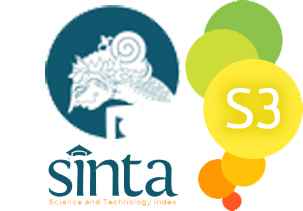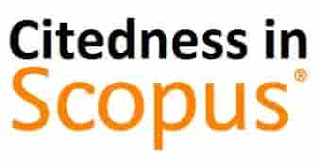Larvicidal Activitytest of Ethanolic Extract Of Citronella Grass (Cymbopogon nardus L.) on Culex sp. Larvae III Instar
Abstract
Culex sp. larvae is a vector of filariasis. The prevention effort is by controlling the presence of Culex sp. Citronella grass is known to contain secondary metabolite which is useful as plant-based insecticides. This research was conducted to determine the toxicity of the ethanolic extract of citronella grass on the mortality of Culex sp. III instar.The research method used was an experimental method with a completely randomized design (CRD) research design, the treatment that was tried was reagent control; negative control; 250 ppm; 353 ppm; 498 ppm; 702 ppm; 991 ppm; 1397 ppm; 1970 ppm, three replications for each treatment. Variables observed were larvae mortality in various concentrations. Larvae mortality was calculated after 24 hours. The data obtained were analyzed using the kruskal wallis test and the man whitney test with SPSS 21 application to determine the LC50value using probit analysis.The results indicate that the ethanolic extract of citronella grass functioned as larvasideonCulex sp. larvae III instar. The higher the concentration of citronella grass extract used, the greater the mortality percentage of Culex sp. larvae. III instar. The concentration of 991 ppm was the most effective concentration and the LC50value was 1036,54 ppm. The conclusion of this research is the ethanolic extract of citronella grass (Cymbopogonnardus L.) has larvicidal activity on Culex sp. larvae. III instar.
References
Aminah, ST., Sigit, S., Partosoedjono, S. & Chairul. 2001. S. larak, D.metel, dan E. prostata sebagai Larvasida Aedes aegypti. Cermin Dunia Kedokteran. No. 131. Hal : 7 – 9.
Atmowidi, T. 2003. Mengapa ditemukan Anomali Keragaman pada Serangga. Makalah Falsafah Sains. 13 November 2003. Bogor : Institut Pertanian Bogor.
Hastuti, H. 2008. Daya Bunuh Ekstrak Daun Pandan Wangi (Pandanus amaryllifolius Roxb.) terhadap Larva Anopheles aconitus Donitz. [Skripsi]. Surakarta: Fakultas Kedokteran UNS.
Hendrik, W., Erwin, & Panggabean, A., Sentosa. 2013. Pemanfaatan Tumbuhan Serai Wangi (Cymbopogon nardus (L.) Rendle) sebagai Antioksidan Alami. Jurnal Kimia Mulawarman, 10(2), 74-79.
Kardinan, A. 2003. Pestisida Nabati Ramuan dan Aplikasinya. Jakarta: Penebar Swadaya.
Naria, E. 2005. Insektisida Nabati untuk Rumah Tangga. Info Kesehatan Masyarakat, 9(1), 28-32.
Nursal, Pasaribu, N. 2003. Indeks Nutrisi Larva Instar V Heliothis Armigera Hubner pada Makanan yang Mengandung Ekstrak Kulit Batang Bakau (Rhizopora Mucronata Lamk.) dan Temperatur yang Berbeda. Diakses tanggal 16 Juli 2019. http://library.usu.ac.id/download/fmipa/biologi-nursal.pdf.
Rocha, D., Olivia, M., Maria, T., Ana, C., Manuel, D., Chtistina, M. 2015. Larvacidal activity against Aedes aegypti of Foeniculum vulgar essential oils from Portugal and Cape Verde. Nat Prod Commun, 10(4), 1-7, doi: 10.5376/jmr.2015.05.0019.
Rumanggit, Hanna, M., Max, J., Runtuwene, & Sri, Sudewi. 2015. Uji Fitokimia dan Uji Aktivitas Antioksidan dari Ekstrak Etanol Spons Lamellodysidea herbacea. Jurnal Ilmiah Farmasi, 4(3), 183-192.
Setyawati, W.,A.,E., Ariani, S.,R.,D., Ashadi, Mulyani, B., & Rahmawati, C.,P. 2014.
Siska, N.K, Budianto, B.H., & Basuki, E. 2018. Stidu Toksisitas: Ekstrak Metanol Bonggol Pisang Ambon (Musa acuminata L. Cv. Gros Michel) terhadap Aedes aegypti (Diptera: Culcidae). Aspirator, 10(2), 93-102.
Suparjo. 2008. Saponin, Peran dan Pengaruhnya bagi Ternak dan Manusia. [Karya Tulis Ilmiah]. Jambi: Fakultas Peternakan Universitas Jambi.
Susanti, L., & Boesri, H. 2012. Toksisitas Biolarvasida Ekstrak Tembakau Dibandingkan dengan Ekstrak Zodia terhadap Jentik Vektor Demam Berdarah Dengue.Buletin Penelitian Kesehatan, 40(2), 75-85.
Yunita, E., Suprapti, N., & Hidayat, J. 2009. Pengaruh Ekstrak Daun Teklan (Eupatorium riparium) terhadap Mortalitas dan Perkembangan Larva Aedes aegypti. Bioma, 11(1), 11-17.























